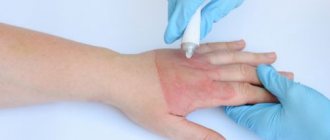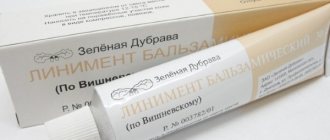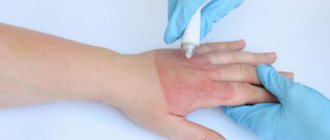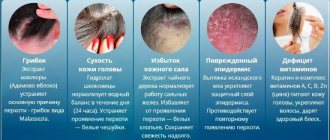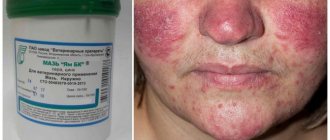On a hike, we take a first aid kit, which allows us to provide the correct first aid that may be needed in emergency situations. Many have used Vishnevsky ointment, but it is worth considering its safety and effectiveness. Some medical professionals say this popular remedy is not as harmless as it seems.
It is worth saying right away that there is no consensus. Over the years of its existence, the product has acquired numerous myths and legends that people pass on to each other. We are not trying to refute the benefits or prove harm, we are trying to describe the pros and cons of the ointment, which was in demand during Soviet times.
Action of liniment
The effectiveness of the drug is achieved by a combination of selected components that enhance each other. Vishnevsky ointment for purulent wounds:
- Gently acts on the open damaged area.
- Increases blood circulation in inflamed skin.
- Eliminates pathogenic microorganisms.
- Thanks to its antiseptic properties, the ointment prevents the development of wound infection.
- Vishnevsky's liniment removes inflammatory signs: swelling, redness, pain in the pathological area.
- Removes purulent, necrotic deposits in an open wound.
- It has a resorption effect, which manifests itself in the upper and lower layers of the epidermis. Thanks to this ability, liniment is used in gynecology to treat the pelvic organs, and in proctology to get rid of hemorrhoids.
- Vishnevsky ointment improves regeneration processes and promotes rapid healing of open wound defects.
Application:
- Doctors recommend applying Vishnevsky ointment to a purulent wound. It draws out pus from the open damaged surface.
- The medication accelerates the cleansing of skin infiltrates: abscesses, acne, boils, carbuncles.
- The drug is used to treat closed injuries with severe inflammation.
- Vishnevsky ointment treats trophic ulcers and bedsores.
- Liniment fights stagnation: lymphangitis, lymphadenitis.
- The drug is used to combat dermatological and infectious skin diseases: erysipelas, streptoderma.
- The medication can be used to lubricate abrasions and lacerated open wounds.
- Surgeons use the medicine after operations.
- The ointment is used to treat burns and frostbite.
Vishnevsky's liniment is a sought-after assistant in medical practice. A wide range of indications allows the drug to be used for various diseases.
Rules for using the product
There are several ways to apply ointment to an open wound. For the procedure you will need gauze, a bandage, a tampon, and a spatula. An important condition for the result is the application of Vishnevsky’s liniment strictly according to the instructions.
- The ointment should be applied to clean skin. Take a bath or shower before doing this.
- Take a wooden spatula or other convenient tool for liniment.
- On an open wound, apply a thin layer of the product on gauze folded several times. The spatula will help distribute the medicine evenly.
- Apply a compress.
- Secure the top with a bandage.
- Keep Vishnevsky ointment on the wound for 12 hours or 24 hours. Compresses need to be changed twice a day.
Second option for applying the drug:
- Using a spatula, lubricate the open pathological area with Vishnevsky ointment.
- Place a piece of thick paper on top.
- Secure the resulting compress with several rounds of bandage.
The course of treatment depends on the patient’s condition, stage and dynamics of the disease. Continuation or termination of treatment of an open wound with Vishnevsky ointment should be discussed with the surgeon.
Contraindications and side effects of the drug
Vishnevsky ointment is not used for extensive purulent processes when surgical intervention is necessary: abscesses, phlegmons. Liniment is not used for the primary treatment of an open wound.
Side effects include a reaction to the ingredients if you are intolerant to them.
In most cases, Vishnevsky ointment gives results without complications. It is used for weakened patients, pregnant women, and young children.
Compliance with the instructions, medical recommendations, and basic rules for handling the medicine helps prevent the development of side effects after treatment of open wounds.
The drug should not be used if the patient has hypersensitivity to the components of the drug.
Composition and properties of A. Vishnevsky’s ointment for purulent abscesses
The product belongs to the group of antibacterial and anti-inflammatory drugs. Code – ATX D08AX. In appearance it is a homogeneous ointment with a specific odor. Color – yellow, yellow-green, green-brown. The drug contains:
- Xeroform – binds to proteins, forms albuminates. The exudation of the abscess is reduced, a protective membrane is formed that protects the nerve endings from irritation. The active substance of the ointment invented by Vishnevsky interacts with the bacterial flora, which causes its inactivation. When used, the severity of inflammation of the abscess and pain syndrome decreases.
- Birch tar is a natural antibacterial agent. It has antimycotic and antiparasitic properties.
The active components of A. Vishnevsky's ointment enhance each other's effect, improve blood supply to the tissues around the abscess, abscess, and prevent secondary infection. This accelerates the maturation of the boil and the cleaning of the wound.
Is there any harm from using ointment?
To understand the harmful properties, let’s go back to the war period of Soviet history. Famous doctors have proven and answered the main question: is Vishnevsky ointment harmful? It creates a special film on the surface of the wound, which should protect against the external influence of microorganisms. However, this film blocks access to cellular respiration, which leads to internal suppuration. According to many experts, during the Second World War, numerous gangrenes of soldiers were caused by the use of Vishnevsky ointment.
The antibacterial effect of this medication has also not been proven, since only the xeroform can have such an effect. Thus, it can be argued that, to some extent, Vishnevsky’s ointment is even dangerous for humans.
Usage
Application of Vishnevsky ointment
Vishnevsky ointment for a hike is suitable in its characteristics. It contains natural ingredients, so the cost of this product is inexpensive compared to other medicines for wounds. Hiking conditions increase the risk of injury, but there is no way to contact a medical professional, so every tourist must have certain first aid medications. The use of Vishnevsky ointment is widespread in the post-Soviet space.
How to use Vishnevsky ointment on wounds? Doctors advise applying a thin layer of gauze to the wound, then applying the gauze to the wound and securing it with a bandage. The main thing is not to overdo it with the amount of product.
The product is used for burns, bruises, calluses, wounds and cuts.
Analogues of Vishnevsky ointment
Currently, a wide variety of products are actively recommended that are effective for treating wounds during a hike. Let's discuss the most popular substitutes.
Levomekol - analogue
- Levomekol. A famous remedy that is found in almost every first aid kit. The ointment can only be stored in the refrigerator, which makes it difficult to use while hiking. Levomekol promotes active tissue restoration, so the wound heals much faster. Levomekol is characterized by the absence of side effects. Which is better: Vishnevsky ointment or Levomekol? Many will definitely name Levomekol.
- Ichthyol ointment. People often prefer this medicine. It has an antimicrobial effect, so it can become an indispensable tool on a hike, suitable even for children.
- Baneocin. A modern version of ointment for all occasions. Many people buy it because it really helps to disinfect the wound and restore damaged dermal tissue.
Treatment rules
Consult your doctor about the advisability of using liniment on an open wound. There are many situations where a drug will do more harm than good.
Vishnevsky ointment must be used following the rules. Before treatment, study the composition of the drug. Pay attention to whether you are allergic to the components of the drug.
Do not exceed the dosage. Apply Vishnevsky ointment according to the instructions, in a thin layer on gauze.
If rashes or redness appear around the open wound, stop treatment and consult a doctor. On sensitive skin, the drug causes an allergic reaction.
Do not use the product internally. Vishnevsky's liniment is intended for outdoor use. Apply to mucous membranes only as directed by a doctor.
Do not mix the medication with other ointments to enhance the therapeutic effect. Contact with the components of another drug may result in an allergic reaction.
Keep the medicine out of the reach of children.
War is a traumatic epidemic
But she provided the most serious assistance during the Great Patriotic War. In those years, two Vishnevsky surgeons treated and operated on the wounded - the inventor of the ointment, Alexander Vasilyevich himself, and his son Alexander Alexandrovich . The latter personally operated on thousands of people; he was the chief surgeon of the Volkhov and Karelian fronts. And then he even became the chief surgeon of the USSR Ministry of Defense.
Doctors call war a traumatic epidemic. And the injuries received in this case are “dirty” - infected with bacteria. Vishnevsky’s ointment was used to treat wounds, because the first antibiotics appeared only at the end of the war.
Article on the topic
Surgeon Loder. What mark did the physician leave on Russian medicine and language?
Military medicine worked super efficiently during the war. 70% of the wounded returned to duty. This is a very high indicator, indicating the quality of the work of doctors. At the turn of the 1930s, Vishnevsky Sr. developed a technology for pain relief using novocaine. It began to be successfully used in many operations instead of anesthesia - general anesthesia. And during the war, local anesthesia began to be used even more often.
The Vishnevsky father and son also developed a new treatment method, using a combination of novocaine and an oil-balsamic dressing (that is, Vishnevsky ointment) to treat inflammatory processes in purulent wounds, abscesses, gangrene, trophic ulcers, thrombophlebitis and other severe complications typical of combat wounds.
The innovations of the Vishnevsky surgeons were also useful in peacetime. After all, the method of pain relief with novocaine was simple, it could be used by ordinary surgeons working in the outback, right down to rural regional hospitals, where general anesthesia was almost impossible. And this also saved thousands of lives, because patients with acute conditions requiring urgent operations did not need to be taken to large hospitals, which would take many hours to get to.
To replace penicillin. What do scientists want to replace antibiotics with? More details
Is it possible to use the ointment invented by Vishnevsky to draw out pus from a pimple?
A pimple is an inflammatory process affecting the hair follicle or developed due to blockage of the sebaceous gland duct or pores on the skin. There is no indication for acne treatment for the use of surgeon Vishnevsky's ointment.
Liniment is used in the following cases:
- furunculosis - damage to the hair follicle by staphylococcus. The ointment is indicated at the stage of formation of a purulent core;
- abscess or boil;
- bedsores - areas that have been subjected to prolonged compression as a result of immobilization of the patient;
- burns;
- inflammatory processes in the lymph nodes;
- trophic ulcers;
- frostbite.
In all cases, treatment is prescribed by the doctor after a visual examination of the patient and the exclusion of contraindications to the use of liniment. Before using Vishnevsky ointment for an abscess on a finger or toe, the stage and reasons for its development should be identified.
